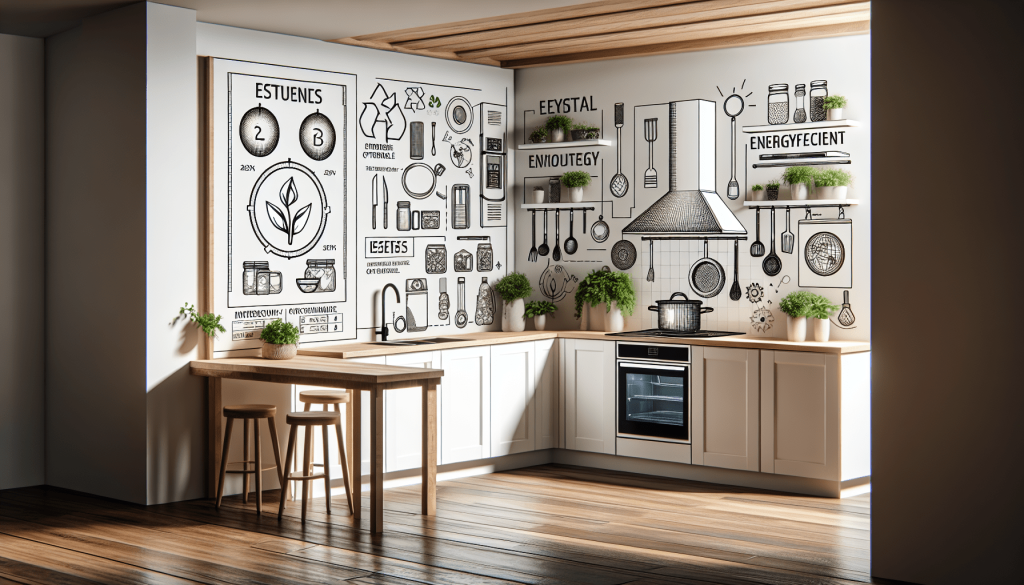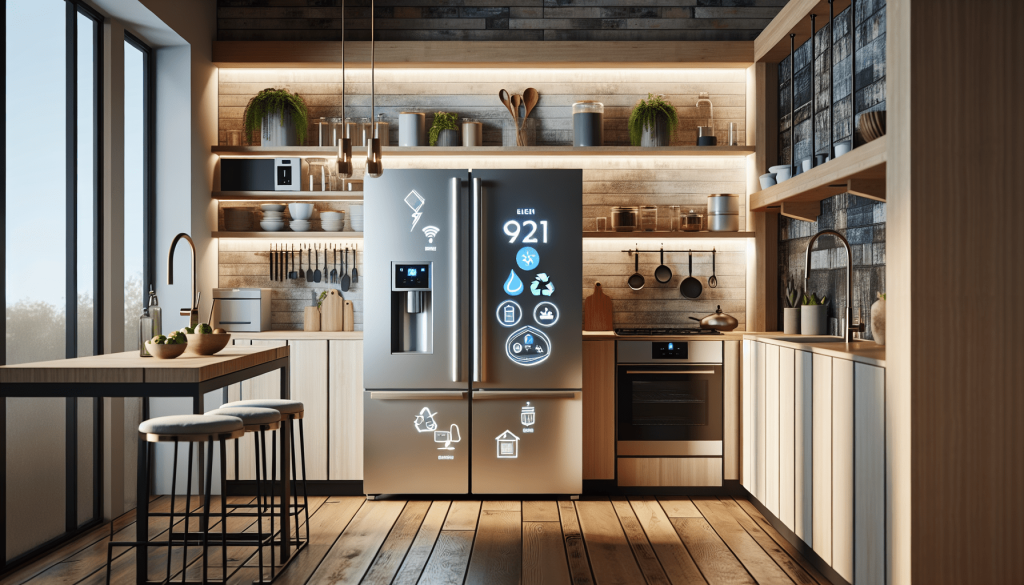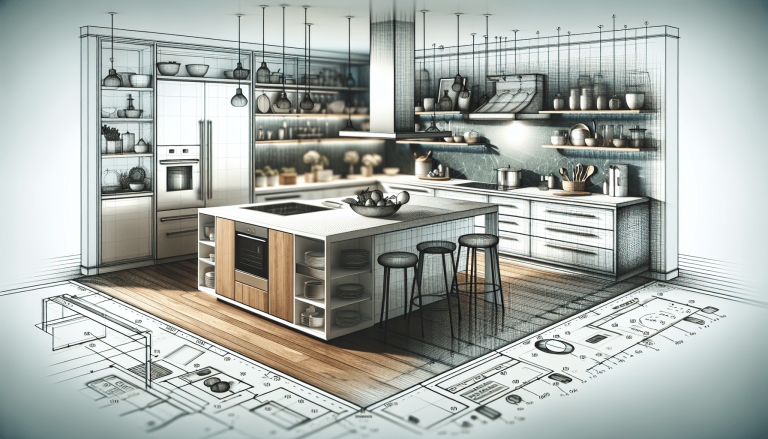When it comes to creating a sustainable kitchen design, it’s important to consider the environment and make conscious choices. From the materials used to the appliances installed, every element can play a role in reducing our carbon footprint. In this article, we will explore some eco-friendly options that you can incorporate into your kitchen design to create a space that not only looks stunning but also supports a greener lifestyle. Whether it’s choosing energy-efficient appliances, opting for recycled or reclaimed materials, or incorporating smart technology, there are numerous ways to make your kitchen more sustainable. Let’s dive in and explore these eco-friendly options together.
Table of Contents
ToggleEnergy-efficient Appliances
When it comes to creating a sustainable kitchen design, choosing energy-efficient appliances is a crucial step. By opting for appliances with high energy star ratings, you can significantly reduce your energy consumption and lower your carbon footprint. Energy star ratings indicate that the appliance meets strict energy efficiency guidelines set by the Environmental Protection Agency. Look for the energy star label on appliances such as refrigerators, dishwashers, and ovens to ensure you’re making the most sustainable choices for your kitchen.
Another eco-friendly option to consider for your kitchen is an induction cooktop instead of a traditional gas stove. Induction cooktops utilize electromagnetic fields to heat up cookware directly, providing faster and more efficient cooking. This not only saves energy but also reduces the amount of heat released into the surrounding environment. Induction cooktops are not only energy-efficient but also safer, as they don’t have an open flame or hot coil.
Investing in a low-energy consumption dishwasher is also an excellent choice for a sustainable kitchen. Look for models with a high energy star rating and features such as water-saving cycles and sensors that adjust water usage based on load size. By using a dishwasher instead of handwashing dishes, you can conserve water and energy more effectively.
Water-saving Fixtures
Conserving water is another essential aspect of a sustainable kitchen design. Install low-flow faucets and showerheads that limit water flow without compromising on functionality. These fixtures can reduce water usage by up to 50% compared to traditional options while still providing a satisfying water flow.
When it comes to dishwashing, choosing a water-efficient dishwasher is a wise choice. Look for models that have high energy star ratings and specific water-saving features. These dishwashers use less water per cycle, ensuring you’re not wasting excess water.
In addition to water-saving fixtures, consider swapping out disposable dish sponges for compostable ones. Disposable sponges contribute to waste and are often made from non-biodegradable materials. Compostable sponges, on the other hand, are made from natural materials and can be composted after use, reducing your environmental impact.
Sustainable Materials
Opting for sustainable materials in your kitchen design is another effective way to create an eco-friendly space. Consider choosing bamboo or reclaimed wood for your flooring. Bamboo is a fast-growing and renewable resource, making it an ideal choice for environmentally-conscious homeowners. Reclaimed wood, sourced from old buildings or furniture, gives a unique and rustic look to your kitchen while reducing the demand for new wood.
For backsplashes, consider using recycled glass or ceramic tiles. These materials are made from waste glass or ceramic and can add a beautiful focal point to your kitchen design while reducing landfill waste. Look for tiles made from recycled content and eco-friendly manufacturing processes.
When it comes to countertops, opt for sustainable materials like bamboo or recycled paper. These materials offer durability while reducing the environmental impact. Recycled paper countertops are made by compressing recycled paper fibers with non-toxic binders, creating a sturdy and eco-friendly option for your kitchen surfaces.
Waste Management
Proper waste management is an integral part of a sustainable kitchen design. Implementing a recycling system in your kitchen makes it easy to separate recyclable items from regular waste. Place recycling bins for paper, plastic, glass, and metal in easily accessible areas to encourage proper sorting and disposal.
In addition to recycling, consider using compost bins for food waste. Composting allows organic waste to decompose naturally, creating nutrient-rich soil for gardens. By composting food waste, you can reduce your contribution to landfill waste and produce eco-friendly fertilizer for plants.
Avoiding single-use plastic items is another crucial aspect of waste management. Instead of using disposable plastic utensils or food storage containers, opt for reusable alternatives like glass containers and stainless steel utensils. These reusable options not only reduce plastic waste but also tend to be more durable and long-lasting.
Natural Lighting
Utilizing natural lighting in your kitchen design not only adds warmth and beauty but also reduces the need for artificial lighting, thereby saving energy. Maximize natural light by incorporating large windows and skylights into your kitchen layout. These features allow ample daylight to stream in, reducing the need for electric lighting during the day.
Choosing light-colored window treatments can also help reflect and amplify natural light in your kitchen. Light-colored curtains, blinds, or shades can bounce sunlight around the room, creating a brighter and more inviting space.
When artificial lighting is necessary, opt for energy-efficient LED bulbs. LED lights are more energy-efficient and last longer than traditional incandescent bulbs. They convert most of the energy they consume into light, making them a sustainable lighting option for your kitchen.
Healthy Indoor Air Quality
Maintaining healthy indoor air quality in your kitchen is essential for the well-being of you and your family. Installing a range hood above your cooking area helps to remove pollutants and improve air circulation. Range hoods vent out smoke, steam, and cooking odors, ensuring clean and fresh air in the kitchen.
When painting walls and cabinets, choose VOC-free (Volatile Organic Compound) paints and finishes. VOCs are chemicals commonly found in many paints and finishes that can release harmful gases into the air, contributing to indoor air pollution. By opting for VOC-free options, you can minimize air pollution in your kitchen and create a healthier environment.
Proper ventilation is also crucial for maintaining good indoor air quality. Ensure your kitchen has adequate airflow through windows, vents, or fans. This helps to remove any lingering odors, moisture, and pollutants, creating a fresh and breathable atmosphere.
Efficient Insulation
Efficient insulation is essential for conserving energy and maintaining a comfortable temperature in your kitchen. Insulate windows and doors to prevent heat loss during colder months and keep the cold air in during the summer. By sealing any gaps or leaks, you can avoid unnecessary energy waste and reduce your utility bills.
Consider using energy-efficient windows, such as those with double or triple glazing. These windows have multiple layers of glass with insulating air or gas trapped between them, providing better insulation than traditional single-pane windows. Energy-efficient windows help to retain heat in the winter and keep the heat out during the summer, reducing the need for excessive heating or cooling.
When it comes to insulation materials, choose eco-friendly options like recycled cellulose or wool. These materials offer excellent thermal performance without harming the environment. Recycled cellulose insulation is made from shredded newspaper treated with non-toxic additives, while wool insulation is sourced from renewable sheep wool.
Smart Kitchen Design
Creating an efficient layout for your kitchen is essential for maximizing space and functionality. Optimize your kitchen layout by considering the work triangle principle, which ensures a smooth flow between the refrigerator, sink, and stove. By minimizing the distance between these three essential areas, you can reduce unnecessary movement and save time and energy.
Ample storage is another key aspect of a smart kitchen design. Include enough cabinets, shelves, and drawers to accommodate all your kitchen essentials. Adequate storage helps to keep your kitchen organized and clutter-free, making it easier to find items and avoid unnecessary purchases. Additionally, choosing high-quality, durable materials for your kitchen furniture and fixtures reduces the need for frequent replacements, further contributing to sustainability.
Efficient Water Heating
Efficient water heating is crucial for reducing water wastage and energy consumption in your kitchen. Consider installing a high-efficiency water heater that utilizes advanced technology to heat water more efficiently. These water heaters can provide hot water on demand while using less energy than traditional models.
Another eco-friendly option for water heating is a solar water heating system. Solar panels installed on your roof or a sunny area of your property can convert sunlight into energy, which heats water stored in a tank. Solar water heating is a renewable and sustainable option, allowing you to reduce your reliance on fossil fuels.
To minimize water wastage, consider using hot water recirculation systems. These systems circulate hot water throughout your plumbing system, reducing the waiting time for hot water to reach faucets or appliances. By having instant hot water available, you can avoid letting the tap run wastefully while waiting for hot water to arrive.
Reusable and Recyclable Kitchenware
Choosing reusable and recyclable kitchenware is a simple yet effective way to make your kitchen more sustainable. Invest in glass containers for food storage instead of using single-use plastic packaging. Glass containers are durable, reusable, and don’t leach harmful chemicals into your food. They also help to reduce plastic waste and promote a more eco-friendly lifestyle.
Opt for stainless steel utensils instead of disposable plastic ones. Stainless steel utensils are strong, long-lasting, and can be easily cleaned and reused. By avoiding single-use plastic utensils, you can drastically reduce the amount of plastic waste generated in your kitchen.
When selecting kitchenware and packaging, choose materials that are recyclable. Look for products made from materials such as glass, metal, or paper, which can be recycled after use. This not only reduces waste but also encourages a circular economy where materials are reused to create new products.
In conclusion, creating a sustainable kitchen design involves making conscious choices in various aspects of your kitchen. By opting for energy-efficient appliances, water-saving fixtures, sustainable materials, waste management systems, and incorporating natural lighting, you can significantly reduce your environmental impact. Prioritizing healthy indoor air quality, efficient insulation, smart kitchen design, and choosing reusable and recyclable kitchenware further enhances the sustainability of your kitchen. By implementing these eco-friendly options, you can create a beautiful and functional kitchen that aligns with your commitment to environmental stewardship.








